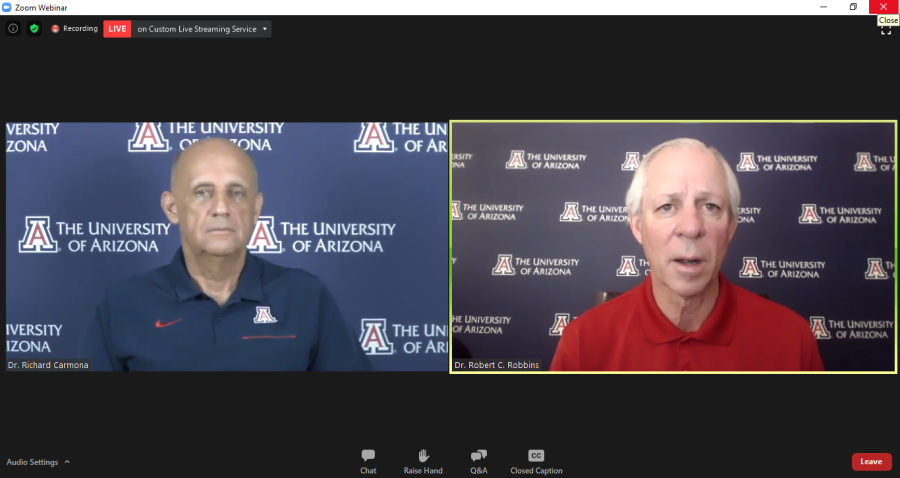University of Arizona President Dr. Robert C. Robbins and Reentry Task Force Director Dr. Richard Carmona met Thursday over Zoom for a virtual press conference to answer questions on different classroom modalities, procedures in residence halls and the furlough plan, which is currently under revision.
Robbins said the university will begin its classes August 24 as scheduled but that “every class will be different.”
RELATED: ICE rescinds recent directive regarding international students following lawsuits from universities
Robbins introduced four modes of classroom instruction in his July 10 email: in-person, flex in-person, live online and iCourse. At the conference, a video was played clarifying the different modalities (36:39 into the live video posted on YouTube).
According to the video, in-person classes will be “just like they sound,” but include “enhanced health protections.”
Flex in-person courses will include a mixture of in-person and online teaching “determined by the instructor.”
In live online instruction, the instructor and the students will be online at the same time, meeting virtually through video calls. According to the video, this method is a “good choice if you plan to learn remotely this semester.”
Finally, iCourses are “online courses that you complete independently through D2L,” essentially functioning like fully online courses have in past semesters.
As of now, courses are being updated to reflect these new modes on UAccess. According to Robbins, each professor will individually determine the mode in which they will teach the class, although there may be some courses that cannot be taught completely online.
“There are unique circumstances that we’re dealing with on a case-by-case basis to be able to make recommendations to the president and the faculty as to how something may be done,” Carmona said, referencing laboratories and research.
Carmona said the university will be enforcing various health checks both before in-person classes and within the dorms.
“We will check our students every morning,” Carmona said. “They’ll have their temperature taken every morning. If they don’t feel well, student health is prepared to engage them quickly and make a determination – is this COVID or is it something else?”
Carmona said the university is working on a system similar to those used in government buildings, where one is checked for symptoms of COVID-19 at the beginning of the day, and if they show no symptoms, they are free to go in and out of the building for the rest of the day.
“Once a student gets checked, we’re looking at ways to be able to identify them,” Carmona said.
Carmona said the university is also working on a system to have daily virtual wellness checks with students living in the dorms.
The wellness check will include “simple questions – ‘How do you feel today? Have you been with somebody that was sick?’ – so we can early identify those who may be at risk,” Carmona said.
Before even moving into the dorms, students will have to complete a test for COVID-19, which the university will both administer and provide the results the day the student moves in.
“You’re going to have to be negative before get in the dorm,” Robbins said. “It was a difficult decision for me to require a test to get into the dormitories, but I felt that it was the only way we could go forward.”
While students are living in the dorms, Robbins said the university will be using “waste water-based epidemiology” and “random sentinel surveillance testing,” but he said “the biggest thing we can do is follow the simple public health hygiene rules.”
Carmona said the UA plans to encourage students to follow these health practices by making it a “social norm.”
He said the UA ambassador program, along with medical school students and UA emergency medical technicians, will be involved in setting examples for students, encouraging them to wash their hands, wear masks and social distance.
“Clearly, this is not a police issue,” Carmona said, “and you don’t want professors getting in arguments with students.”
However, Robbins said should these methods fail, administration does have the ability to restrict gatherings and take other disciplinary measures, but he said he was “confident that we will be able to make meaningful changes and provide the opportunity for individuals to come back to the campus in some modality and continue their education.”
In addition to campus procedures, Robbins also spoke on the university’s furlough plan’s implementation, which was pushed back to August 10.
He said Provost Liesl Folks and Chief Financial Officer Lisa Rulney are part of a committee alongside members of the Coalition for Academic Justice at the University of Arizona, an organization of university faculty and staff that proposed a revised furlough plan, to discuss potential changes to the plan. Robbins said he hopes the committee will be able to meet daily.
“I’m open to anything that [CAJUA] can do to help us do,” Robbins said.
These press conferences will continue in a virtual format for the next few weeks, according to Robbins, with the next one scheduled for Thursday, July 23, at 10 a.m.
The full press conference is available on the UA’s YouTube channel.
Follow Sam Burdette on Twitter









